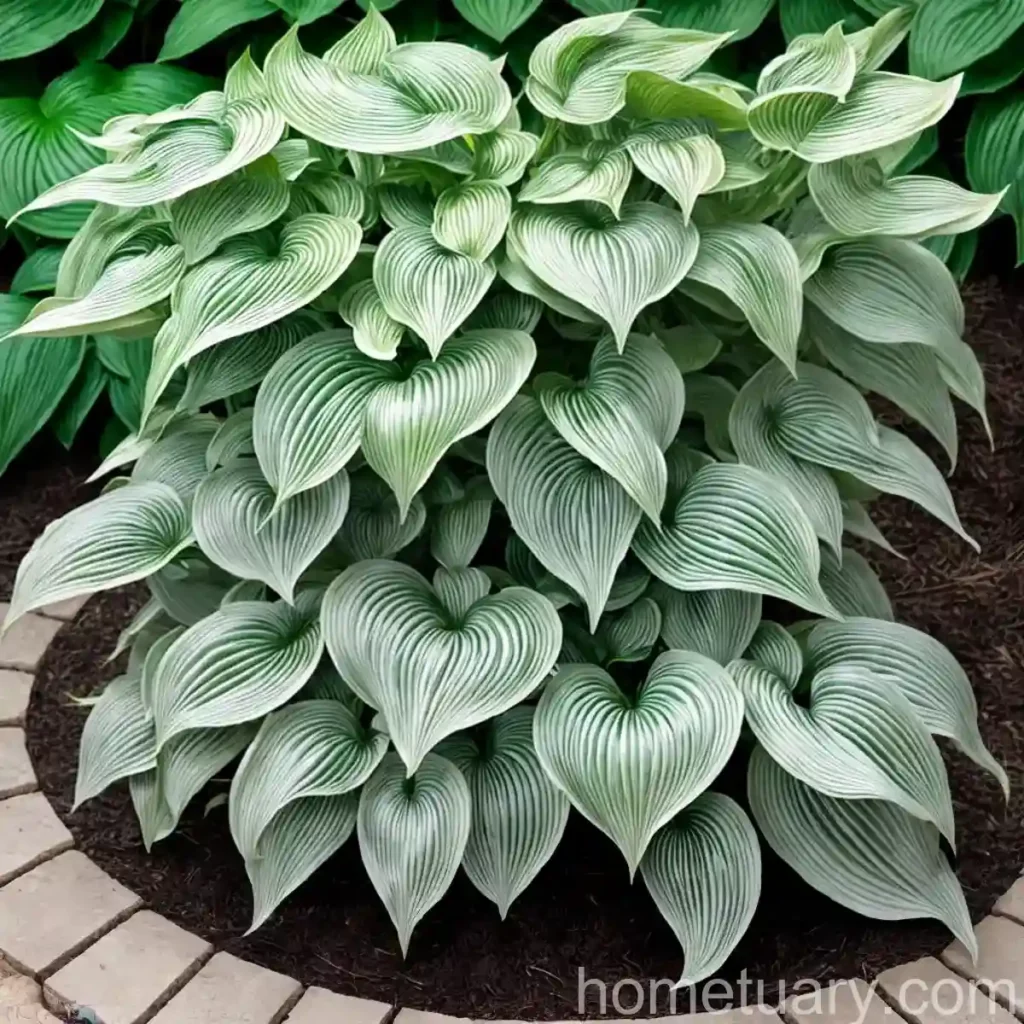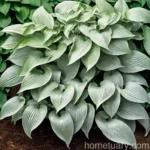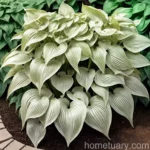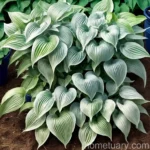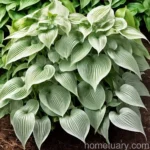Hosta (Hosta ‘Wolverine’): The Ultimate Guide
Hostas are a popular choice for many gardeners looking to add beauty and elegance to their outdoor spaces. Hosta ‘Wolverine’ is a particularly stunning variety with unique characteristics that make it a standout plant in any landscape. In this comprehensive guide, we will explore everything you need to know about Hosta ‘Wolverine’ – from its cultural requirements to propagation, common diseases, and fun facts. Whether you are a seasoned gardener or just starting with your green thumb, this guide will provide you with all the information you need to successfully grow and care for Hosta ‘Wolverine’.
What is Hosta ‘Wolverine’?
Hosta, commonly known as plantain lily, is a genus of plants native to northeast Asia. They are herbaceous perennial plants known for their lush foliage and delicate flowers, making them a popular choice for shady gardens. Hosta ‘Wolverine’ is a variety of hosta that is prized for its striking variegated leaves and tolerance to different growing conditions.
Key Takeaways – Hosta (Hosta ‘Wolverine’)
Before delving into the details, let’s take a quick look at the key takeaways for Hosta ‘Wolverine’.
- Hosta ‘Wolverine’ is a shade-loving plant with striking variegated foliage.
- It is a low-maintenance plant that is suitable for various landscape uses, including borders, ground cover, and container gardening.
- Hosta ‘Wolverine’ requires regular watering, well-draining soil, and partial to full shade for optimal growth.
- Proper fertilization, pruning, and mulching can help maintain the health and vigor of Hosta ‘Wolverine’.
- The plant is susceptible to certain diseases and pests, requiring proper care and vigilance for prevention and management.
Now, let’s delve deeper into various aspects of Hosta ‘Wolverine’ to understand its culture, uses, care requirements, and more.
Culture
Understanding the cultural requirements of Hosta ‘Wolverine’ is essential for its successful growth and development. This includes factors such as water, sunlight, fertilizer, soil, and pruning.
Uses
Hosta ‘Wolverine’ is a versatile plant with various uses in landscaping and gardening. Some of its common uses include:
-
Border plant: The lush foliage and low-growing habit of Hosta ‘Wolverine’ make it an excellent choice for creating borders in gardens and pathways.
-
Ground cover: In shaded areas where grass struggles to grow, Hosta ‘Wolverine’ can serve as a beautiful and low-maintenance ground cover.
-
Container gardening: The compact size and aesthetic appeal of Hosta ‘Wolverine’ make it perfect for container gardening, adding visual interest to patios, balconies, and other outdoor spaces.
-
Shade gardens: Due to its shade-loving nature, Hosta ‘Wolverine’ thrives in shaded or partially shaded garden areas, adding color and texture to such spaces.
Water
Proper watering is crucial for the health and vitality of Hosta ‘Wolverine’. While it is essential to keep the soil consistently moist, overwatering can lead to issues such as root rot. Consider the following tips for watering Hosta ‘Wolverine’:
-
Consistent Moisture: Hosta ‘Wolverine’ prefers consistently moist soil. Regular watering, especially during dry spells, is important to ensure adequate moisture levels.
-
Avoid Waterlogging: While the plant requires moisture, waterlogged soil can lead to root rot and other problems. Ensure that the soil has good drainage to prevent waterlogging.
-
Mulching: Applying a layer of organic mulch around the base of the plant can help retain soil moisture and regulate temperature, reducing the frequency of watering.
Sunlight
Hosta ‘Wolverine’ is well-known for its ability to thrive in shady conditions, although it can also tolerate some sunlight. Understanding its sunlight requirements is essential for optimal growth:
-
Partial Shade: Hosta ‘Wolverine’ thrives in partial shade, making it ideal for planting under trees or in areas with dappled sunlight.
-
Sunlight Tolerance: While it prefers shade, Hosta ‘Wolverine’ can tolerate some morning sun or filtered sunlight. However, prolonged exposure to direct sunlight can lead to leaf burn and reduced vigor.
-
Adapting to Conditions: The plant can adapt to different light levels, but excessive sun exposure can affect its overall health and appearance.
Fertilizer
Proper fertilization is important for enhancing the growth and foliage of Hosta ‘Wolverine’. Consider the following tips for fertilizing this plant:
-
Balanced Fertilizer: Use a balanced, slow-release fertilizer specifically formulated for shade-loving plants. Avoid high-nitrogen fertilizers, as they can lead to excessive leaf growth at the expense of flowering.
-
Application Timing: Apply fertilizer in early spring, just as the new leaves are emerging. A second application in mid-summer can help maintain the plant’s vigor.
-
Avoid Overfertilization: Excessive fertilizer can lead to rapid but weak growth, making the plant more susceptible to pests and diseases. Follow the recommended application rates for best results.
Soil
The soil composition and quality play a significant role in the overall health and growth of Hosta ‘Wolverine’. Consider the following aspects when selecting and preparing soil for this plant:
-
Well-Draining Soil: Hosta ‘Wolverine’ thrives in well-draining, humus-rich soil. Heavy clay soils should be amended with organic matter to improve drainage and fertility.
-
pH Level: The ideal soil pH for Hosta ‘Wolverine’ is slightly acidic to neutral, typically in the range of 6.0 to 7.5. Conduct a soil test to determine the pH and make appropriate adjustments if necessary.
-
Soil Moisture: While the plant prefers consistent moisture, it is important to avoid waterlogged conditions. Well-draining soil helps prevent waterlogging and root rot.
Pruning
Pruning is an essential aspect of maintaining the aesthetics and health of Hosta ‘Wolverine’. Consider the following tips for pruning this plant:
-
Removing Dead Foliage: Regularly remove any dead or damaged leaves to promote airflow and prevent the spread of diseases.
-
Flower Removal: Hosta ‘Wolverine’ produces attractive flowers, but some gardeners prefer to remove the flower stalks to direct the plant’s energy towards foliage growth.
-
Division: Periodic division of mature clumps can rejuvenate the plant, promote vigorous growth, and prevent overcrowding.
Propagation
Propagating Hosta ‘Wolverine’ allows you to expand your collection of these beautiful plants or share them with fellow gardeners. There are several methods of propagation to consider:
-
Division: Division is the most common and reliable method of propagating Hosta ‘Wolverine’. This involves separating the plant’s clumps into smaller sections, each with its own roots and shoots.
-
Seed Propagation: While less common, growing Hosta ‘Wolverine’ from seeds is also a viable option. However, it requires more time and patience compared to division.
-
Propagation Timing: The best time to divide or propagate Hosta ‘Wolverine’ is in early spring or after the plant has finished flowering in the summer.
-
Proper Care: Newly propagated or divided plants require appropriate watering and care to help them establish and thrive in their new growing locations.
Container Popularity
The compact size and attractive foliage of Hosta ‘Wolverine’ make it a popular choice for container gardening. Whether you have a small patio, balcony, or garden space, growing Hosta ‘Wolverine’ in containers offers several benefits:
-
Space Utilization: Containers allow you to grow Hosta ‘Wolverine’ in areas where traditional ground planting may not be feasible, such as urban settings or small outdoor spaces.
-
Design Flexibility: Containers offer design flexibility, allowing you to showcase Hosta ‘Wolverine’ as standalone specimens or as part of mixed container arrangements.
-
Portability: Containers enable easy movement of the plants, allowing you to create temporary displays or protect the plants from extreme weather conditions.
-
Soil and Water Management: Growing Hosta ‘Wolverine’ in containers allows you to control the soil quality, moisture levels, and drainage more effectively.
Common Diseases
Like many plants, Hosta ‘Wolverine’ is susceptible to certain diseases that can affect its overall health and appearance. Understanding these common diseases and their symptoms is critical for timely intervention and management.
Disease Diagnosis
Hosta ‘Wolverine’ may be prone to the following common diseases, each with its own set of symptoms and management strategies:
-
Hosta Virus X (HVX): This viral disease manifests as yellow or green streaking on the leaves, distorted foliage, and stunted growth. Infected plants should be promptly removed and destroyed to prevent the spread of the virus to healthy plants.
-
Fungal Leaf Spot: Fungal leaf spot appears as dark, water-soaked lesions on the foliage. Proper sanitation, adequate airflow, and fungicidal treatments can help manage this disease.
-
Crown and Root Rots: Excessive soil moisture and poor drainage can lead to crown and root rots. Symptoms include wilting, yellowing, and decay of the plant’s crown and roots. Improving soil drainage and avoiding overwatering are essential for prevention.
-
Slime Mold: Slime mold appears as slimy, mold-like growth on the leaves of Hosta ‘Wolverine’. While it is not typically harmful to the plant, it can be unsightly. Good garden hygiene and proper air circulation can help minimize its occurrence.
Common Pests
In addition to diseases, Hosta ‘Wolverine’ may also be susceptible to various pests that can compromise the plant’s health and appearance. Some of the common pests to watch out for include:
-
Slugs and Snails: These mollusks are notorious for feeding on hosta foliage, leaving behind characteristic irregular holes. Physical barriers, natural predators, and slug baits can help manage their populations.
-
Deer and Rabbits: Hosta ‘Wolverine’ is often a favored snack for deer and rabbits. Fencing and deer-resistant techniques can help protect the plants from browsing.
-
Sucking Insects: Aphids, thrips, and spider mites are among the common sucking insects that can infest Hosta ‘Wolverine’. Regular inspection and the application of horticultural oils or insecticidal soaps can help manage these pests.
-
Voles and Rodents: These pests can cause damage to the plant’s roots and underground structures. Proper garden hygiene and the use of deterrents can help protect Hosta ‘Wolverine’ from voles and rodents.
Botanist’s Tips
As a plant scientist and botanist, I would like to share some additional tips and insights on growing and caring for Hosta ‘Wolverine’. These tips are based on scientific knowledge and practical experience, aimed at helping you achieve success with this beautiful plant.
-
Mulching Benefits: Applying mulch around the base of Hosta ‘Wolverine’ not only helps retain soil moisture, but it also provides insulation, suppresses weeds, and enhances the overall aesthetics of the garden.
-
Air Circulation: Adequate airflow is crucial for preventing fungal diseases and promoting the overall health of the plant. Avoid overcrowding and maintain proper spacing between Hosta ‘Wolverine’ and other plants.
-
Soil Testing: Conducting regular soil tests can provide valuable insights into the nutrient levels and pH of the soil, allowing you to make informed decisions regarding fertilization and soil amendments.
-
Companion Planting: Hosta ‘Wolverine’ pairs well with various companion plants, such as ferns, astilbes, and heucheras. When selecting companion plants, consider factors such as shade tolerance and soil requirements for optimal compatibility.
-
Seasonal Care: Hosta ‘Wolverine’ may exhibit different growth patterns and requirements during different seasons. Pay attention to seasonal care practices, such as winter protection and summer watering, to ensure the plant’s long-term health.
Fun Facts
Hosta ‘Wolverine’ is not only a visually stunning plant, but it also possesses interesting characteristics and facts that make it a delightful addition to any garden. Here are some fun facts about Hosta ‘Wolverine’:
-
Leaf Diversity: The foliage of Hosta ‘Wolverine’ exhibits an incredible diversity of colors, patterns, and textures, making each plant a unique and captivating specimen.
-
Edible Flowers: While primarily grown for their ornamental foliage, Hosta flowers are edible and can be used to add a touch of elegance to salads and other culinary creations.
-
Native Origins: Hosta plants, including ‘Wolverine’, are native to Japan, Korea, and China, and have been cultivated for centuries for their ornamental and culinary uses.
-
Longevity: When provided with proper care, Hosta ‘Wolverine’ can live for many years, with some mature specimens exhibiting resilience and vitality for decades.
-
Collector’s Appeal: Hosta enthusiasts and collectors often seek out rare and unusual varieties, leading to a vibrant and diverse community of hosta aficionados.
Links to External Resources
For further information on Hosta ‘Wolverine’, hosta gardening, and related topics, I recommend exploring the following external resources:
-
American Hosta Society: The American Hosta Society website offers a wealth of information on hostas, including cultivation tips, plant profiles, and membership opportunities.
-
The Hosta Library: This comprehensive online resource is a treasure trove of hosta information, featuring a vast collection of images, articles, and resources for enthusiasts.
-
Gardening Know How – Hosta Plants: Gardening Know How provides numerous articles and guides on growing hostas, including care tips, pest management, and landscaping ideas.
-
University Extension Websites: Many university extension websites offer evidence-based guidelines for gardening, including specific information on growing hostas in different regions.
In conclusion, Hosta ‘Wolverine’ is a captivating and versatile plant that can enhance any garden or landscape with its unique foliage and low-maintenance nature. By understanding its cultural requirements, uses, and care tips, you can cultivate and enjoy the beauty of Hosta ‘Wolverine’ in your own outdoor spaces.
Remember to explore additional resources and seek guidance from local gardening experts to further enrich your knowledge and experience with Hosta ‘Wolverine’ and other hosta varieties. Whether you are creating a serene shade garden or enhancing your existing landscape, Hosta ‘Wolverine’ is sure to leave a lasting impression with its elegance and charm.

